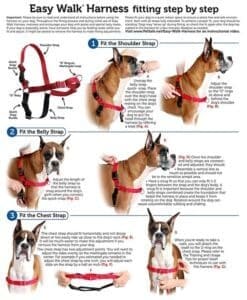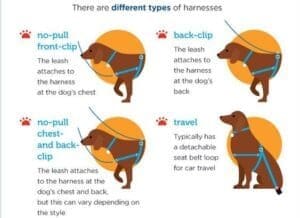Considering dog training but unsure about choosing between a harness and a collar? Dive into the benefits and considerations of the Harness vs. Collar debate for dog training. Whether you’re a future dog owner or contemplating a training method change, understanding the advantages and potential drawbacks of each option can guide you in making an informed decision that prioritizes your pet’s comfort and training needs. Let’s explore and determine which option suits your four-legged companion best!
Benefits of Using a Harness
Reduces Neck Strain
One of the main benefits of using a harness for your dog is that it reduces the strain on their neck. Unlike a collar, which puts direct pressure on the dog’s throat area, a harness distributes the force evenly across their chest and shoulders. This can be especially important for dogs with delicate necks or those prone to neck injuries.
Provides Better Control
Using a harness gives you greater control over your dog’s movements. With the leash attachment point on the back of the harness, you can guide your dog more effectively and prevent them from pulling or lunging. This is especially helpful for large or strong dogs who have a tendency to pull on the leash.
Distributes Force Evenly
One of the key advantages of a harness is that it distributes force evenly throughout your dog’s body. This means that when your dog pulls on the leash, the pressure is spread across their chest and shoulders rather than focused on their neck. This not only reduces the risk of injury but also makes it easier for you to control your dog.
Prevents Tracheal Damage
Using a collar can put pressure on your dog’s windpipe and cause tracheal damage, especially if your dog pulls on the leash. A harness eliminates this risk by avoiding any pressure on the throat area. This makes harnesses an ideal choice for dogs with respiratory issues or those prone to tracheal collapse.
Ideal for Small Breeds
For small breeds, a harness is often a better option than a collar. Small dogs are more delicate, and the pressure from a collar can cause neck strains or injuries. By using a harness, you can ensure their comfort and safety during walks.
Supports Dogs with Health Issues
If your dog has certain health issues, such as arthritis or back problems, a harness can provide them with extra support. A harness allows you to assist your dog when needed and reduces the strain on their body. It’s always important to consult with your veterinarian before using a harness for a dog with health issues to ensure it is suitable for their specific condition.
Considerations for Using a Harness
Proper Fit is Crucial
When using a harness, it’s essential to ensure it fits your dog properly. A poorly fitting harness can cause discomfort, chafing, and restricted movement. Measure your dog’s girth and follow the manufacturer’s sizing guide to find the right fit. Regularly check the fit of the harness, especially as your dog grows or gains/loses weight.
Requires Training
While a harness can help with control, it doesn’t automatically make your dog well-behaved on walks. It’s important to train your dog to walk calmly on a leash while using a harness. Teach them basic commands and practice loose leash walking techniques to make walks enjoyable for both you and your furry friend.
May Encourage Pulling
In some cases, using a harness can inadvertently encourage pulling behaviour in dogs. If your dog is already inclined to pull on the leash, the added support and freedom of movement that a harness provides may make it easier for them to continue pulling. This is why it’s crucial to combine harness use with proper leash training.
Not Suitable for All Breeds
While a harness can be beneficial for many dogs, it may not be suitable for every breed. Some breeds, such as Greyhounds or Whippets, have a unique body structure that may not be compatible with a harness. Additionally, certain brachycephalic breeds with respiratory issues may also require specialized harnesses to accommodate their specific needs. Consult with a professional or your veterinarian to determine if a harness is suitable for your dog’s breed.
Bulkier and Less Stylish
Compared to collars, harnesses are generally bulkier and may not have the same aesthetic appeal. If style is a priority for you, collars often offer a more sleek and fashionable look. However, keep in mind that functionality and your dog’s comfort should always be the top priority when choosing equipment for walks.
Not Ideal for Quick Restraint
If you need to quickly restrain your dog, such as in an emergency situation, a harness may prove less practical than a collar. Harnesses usually take a bit more time to put on and adjust, while collars can be easily slipped over your dog’s head. Consider your specific needs and situations when deciding between a harness and a collar.
Benefits of Using a Collar
Simpler Design
Collars have a simpler design compared to harnesses. They consist of a band that goes around the dog’s neck, often with a buckle or clip for easy adjustment. This simplicity makes collars lightweight and easy to use.
Easy to Put On and Remove
Collars are much easier to put on and remove compared to harnesses, which can take time to adjust and fit properly. A collar can be quickly slipped over your dog’s head, making it convenient for daily use and quick outings.
Facilitates Quick Leash Attachment
With a collar, you can easily attach the leash to the D-ring, allowing for quick and effortless leash attachment. This can be particularly useful when you need to take your dog outside for a quick potty break or when you want to keep them close by in a controlled environment.
More Affordable Option
Collars are generally more affordable compared to harnesses. With a wide range of options available, you can find collars to fit different budgets without compromising quality. If budget is a concern, a collar may be a more cost-effective choice.
Allows Better Communication
Some dog owners prefer using collars for training purposes as they allow for better communication. The quick tug of a collar can be an effective way to redirect or correct your dog’s behaviour, especially during obedience training. The immediate feedback provided by a collar can aid in teaching your dog commands and enforcing boundaries.
Suitable for Dogs Accustomed to Collars
For dogs that have been wearing collars since they were puppies, transitioning to a harness may be challenging. Collars provide a familiar and secure feeling for these dogs and can be a suitable option for their training needs.
Considerations for Using a Collar
Potential Neck and Spine Injuries
One of the biggest concerns with using a collar is the potential for neck and spine injuries. If your dog pulls on the leash or jerks suddenly while wearing a collar, it can put immense pressure on their neck and spine, leading to injuries or even long-term damage. This is particularly true for small or delicate breeds.
Risk of Choking and Tracheal Damage
Similar to using a harness incorrectly, using a collar incorrectly can pose a risk of choking and tracheal damage. If the collar is too tight or if your dog pulls excessively while wearing it, it can restrict airflow and cause discomfort or injury to their throat.
Increased Strain on the Neck
Even without pulling, the pressure exerted by the collar during regular leash walking can strain your dog’s neck. This strain can lead to discomfort, pain, and potential physical issues over time.
Not Recommended for Dogs Prone to Pulling
If your dog is prone to pulling on the leash, using a collar may exacerbate the problem. The pressure on their neck can create a reflexive response to pull even harder, making it difficult to control them. In these cases, a harness may be a more suitable option to prevent injury and improve control.
May Worsen Behavioral Issues
Some dogs may exhibit behavioral issues, such as aggression or anxiety, that can be exacerbated by the use of a collar. The pressure and jerking associated with collar corrections can increase stress levels and potentially escalate negative behaviors. Consult with a professional trainer or behaviorist to determine the best training tool for addressing your dog’s specific behavioral issues.
Not Suitable for Toy Breeds or Puppies
Toy breeds and puppies have delicate necks and bodies that are more susceptible to injury. A collar, even of appropriate size, may put too much strain on their small frames and can lead to neck and tracheal problems. For these small and growing dogs, a harness is generally a safer and more suitable choice.
Choosing the Right Training Tool
Consider Your Dog’s Size and Breed
When deciding between a harness and a collar, take into consideration your dog’s size and breed. Certain breeds may have specific needs or characteristics that make one option more suitable than the other. Additionally, dogs with specific health conditions may require specialized equipment.
Assess Training Needs and Goals
Consider your training goals and the specific behaviors you want to address. Each training tool has its advantages and disadvantages, and choosing the right one depends on your individual dog’s training needs and your preferred training techniques.
Consult Professional Trainers
If you’re unsure which training tool is best for your dog, consulting with professional trainers can provide valuable insights. They can evaluate your dog’s temperament, behavior, and physical attributes, and recommend the most suitable training equipment.
Take Your Dog’s Health into Account
Your dog’s health should always be a top priority when selecting a training tool. Certain health conditions, such as respiratory issues or musculoskeletal problems, may make one option more suitable than the other. Consult with your veterinarian to ensure you make an informed decision that promotes your dog’s well-being.
Consider Leash Walking Style
Think about your desired leash walking style when choosing between a harness and a collar. If you prefer a more controlled and restrained walk, a collar may be the better option. If you want to give your dog more freedom to explore and reduce the risk of injury from pulling, a harness may be the more appropriate choice.
Training Tips for Harness Users
Start with Positive Reinforcement
When introducing your dog to a harness, start with positive reinforcement. Associate the harness with positive experiences by rewarding your dog with treats and praise when they have the harness on. This will create a positive association and make them more receptive to wearing it.
Get the Right Fit
Ensuring the harness fits properly is key to your dog’s comfort and safety. Follow the manufacturer’s guidelines for measuring and selecting the right size for your dog. Adjust the straps accordingly to achieve a snug, but not tight, fit. Regularly check and readjust the fit as needed, particularly if your dog is still growing or has gained/lost weight.
Gradually Introduce and Familiarize
Introduce the harness gradually to your dog. Allow them to sniff and investigate it before putting it on. Start by having them wear the harness for short periods indoors, gradually increasing the duration. This gradual approach helps them become comfortable and familiar with the sensation of wearing a harness.
Use Treats and Rewards
Use treats and rewards to reinforce positive behavior during training sessions with the harness. Reward your dog for calmly walking on a loose leash, responding to commands, or exhibiting good behavior while wearing the harness. This positive reinforcement will help them associate wearing the harness with enjoyable experiences.
Be Patient and Consistent
Training your dog to walk on a leash with a harness takes time and patience. Be consistent in your training methods and expectations. If your dog becomes overwhelmed or resistant to the harness, take a step back and allow them more time to adjust. With consistency and positive reinforcement, your dog will become more comfortable with wearing the harness and walking on a leash.
Training Tips for Collar Users
Choose the Proper Collar Type
There are various types of collars available, including flat collars, martingale collars, and head halters. Choose the collar type that is most suitable for your dog’s needs and training goals. Consult with a professional trainer or behaviorist if you’re uncertain which collar type is appropriate for your dog.
Ensure Proper Fit
Just like with a harness, it’s crucial to ensure the collar fits your dog comfortably. It should be snug enough that it doesn’t slip over their head, but not so tight that it restricts their breathing or causes discomfort. Regularly check and readjust the fit, especially as your dog grows or experiences weight fluctuations.
Never Use Excessive Force
Using excessive force on a collar can lead to injury and negative associations with training. Avoid harsh corrections or yanking on the leash, as this can cause physical and emotional harm to your dog. Training should focus on positive reinforcement and gentle guidance to encourage desired behavior.
Utilize Leash Corrections Wisely
If gentle guidance with the leash is not enough to redirect unwanted behavior, use appropriate leash corrections. A leash correction involves a quick, firm tug on the leash to redirect your dog’s attention. Timing and technique are key to ensuring the correction is effective and humane. Consult with a professional trainer to learn proper leash correction techniques.
Combine with Positive Reinforcement
To create a positive training experience, always combine collar use with positive reinforcement. Reward your dog for good behavior with treats, praise, or playtime. This combination of positive reinforcement and gentle corrections can effectively shape your dog’s behavior while maintaining a positive and trusting relationship.
Avoiding Common Mistakes
Using Incorrectly Sized Harness or Collar
Using a harness or collar that doesn’t fit your dog properly can lead to discomfort, injury, and an ineffective training experience. Take the time to measure and select the right size for your dog, and regularly check the fit to ensure it remains appropriate.
Using Inappropriate Training Techniques
Using harsh or punitive training techniques with either a harness or collar can have negative consequences for your dog’s well-being and behavior. It’s important to educate yourself on positive reinforcement training methods and consult with a professional trainer to ensure you are using appropriate and effective techniques.
Overlooking Regular Inspection and Adjustment
As your dog grows or experiences weight fluctuations, their harness or collar may require adjustment. Failure to regularly inspect and adjust the fit can compromise your dog’s comfort and safety. Regularly check for any signs of wear or damage, and ensure a proper fit for optimal results.
Neglecting Continual Training Reinforcement
Training is an ongoing process, and consistent reinforcement is necessary to maintain desired behaviors. Continually reinforce leash manners, commands, and walking techniques to ensure your dog understands and responds appropriately while wearing a harness or collar.
Failing to Monitor for Discomfort or Injury
Always monitor your dog for any signs of discomfort or injury when using a harness or collar. Pay attention to their behavior, posture, and physical reactions during walks. If you notice any signs of distress or discomfort, consult with your veterinarian or a professional trainer to address the issue promptly.
Summary: Which is Best?
When it comes to choosing between a harness and a collar, there isn’t a one-size-fits-all answer. The best option depends on your individual dog’s needs, training goals, and physical characteristics.
Consider your dog’s health and body structure, as well as the specific training techniques you plan to use. Consult with professional trainers or behaviorists who can assess your dog’s needs and recommend the most suitable training tool.
Keep in mind that harnesses provide better control, distribute force evenly, and can help reduce neck strain, making them beneficial for many dogs. Collars, on the other hand, are simpler, easier to use, and allow for better communication during training sessions.
Ultimately, both harnesses and collars can have a place in your training arsenal, and the most effective approach may involve using a combination of both depending on the situation. By considering your dog’s individual needs and consulting with professionals, you can make an informed decision and provide your furry friend with a safe and effective training experience.




